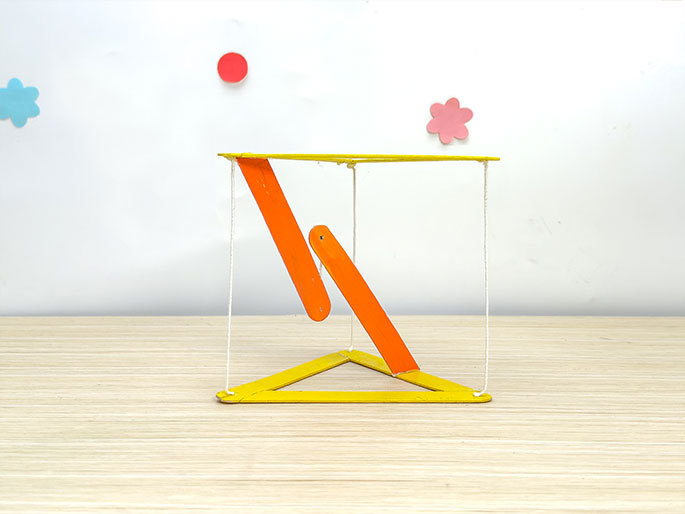Anti-Gravity Suspension Frame
Stem Activities

Ages: 6-8

Greater than 30 minutes

Grownup needed
Many buildings and art installations can maintain strange angles without collapsing - some even appear to float in mid-air defying logic. But how is this possible? Create this seemingly magical anti-gravity device using cotton string and lolly sticks to explore the fascinating science behind making objects 'float'.
Materials Needed
- 8 lolly sticks
- Paint palette
- Pencil
- Paintbrush
- Ruler
- Cotton string
- Paint
- Glue
- Craft knife
- Scissors

Step-by-step tutorial
Paint the lolly sticks in your favourite colours.

Once dry, arrange the lolly sticks according to the numbered sequence shown in the image.

Using the pencil, draw guide lines where the lolly sticks overlap.

Repeat the same process to mark guide lines on the other three lolly sticks.

Using scissors, cut the lolly sticks along the guide lines.
Apply glue to the cut edges and join three sticks to form a triangle as shown. You'll need to make two of these triangles.

Using the craft knife, make small holes at each corner of the glued triangles large enough for the string to pass through.
Take the remaining two lolly sticks and mark them at 10cm and 11cm respectively, then connect these lines as shown.

Cut both lolly sticks along the connected lines.
Make a small hole at one end of each uncut lolly stick using the craft knife.
Take one of the cut lolly sticks, apply glue to the cut edge, and attach it to the centre of one edge of a triangle.

Apply glue to the cut edge of the other cut lolly stick and attach it to the centre of one corner of the second triangle as shown. Be careful not to cover the holes in the triangle.
Cut three 15cm lengths and one 6cm length of string.
Once the glue from step 11 is dry, thread and secure the strings through the prepared holes.
Turn the assembly from step 12 upside down, positioning the corner with the attached stick on the left. Thread the strings through the corresponding holes and secure them, ensuring the middle two sticks align.

Your anti-gravity suspension frame is now complete. Lift the top stick and watch the magic happen!

The Science Behind It:
The anti-gravity suspension frame works by utilising force balance and tension to create a stable structure. When the strings are pulled taut, they create internal tension that counteracts the structure's natural tendency to fall under gravity, resulting in stable equilibrium.

 STEM Activities
STEM Activities Artistic Adventures
Artistic Adventures Playful Learning
Playful Learning The Recipe Repository
The Recipe Repository  Nature Explorations
Nature Explorations












